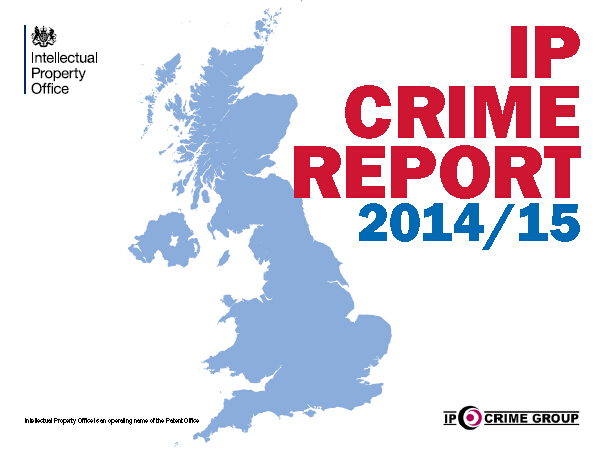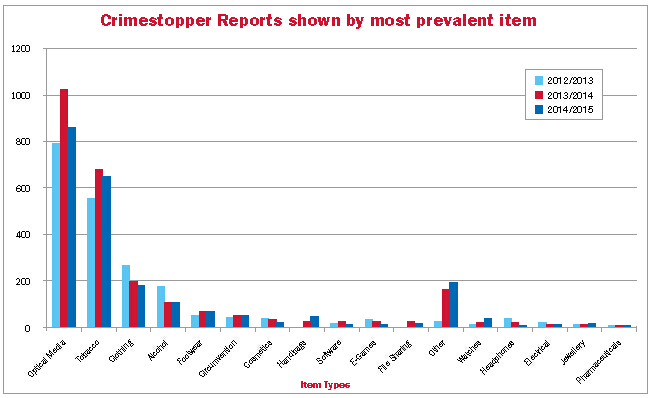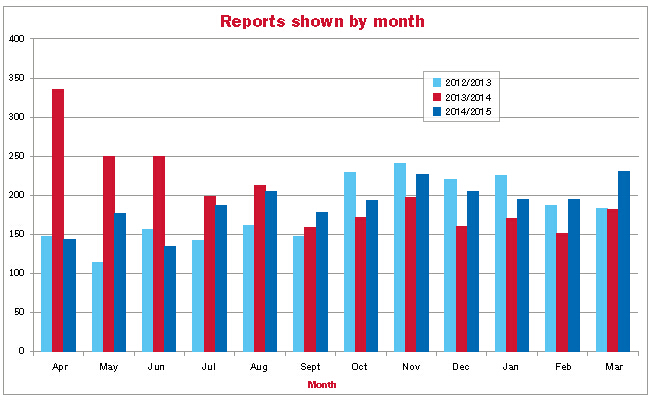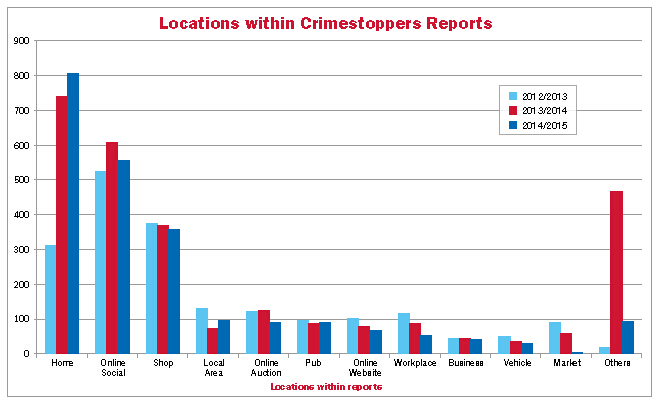UK IP CRIME REPORT 2014/15
Chapter 1 - What is the scale of IP crime in the UK?
The breadth of goods and services that attract the interest of IP counterfeiters and pirates continues to evolve. Chapter 1 illustrates how work by industry and law enforcement this year has highlighted the sale, importation and availability of luxury goods, toys, and electrical items such as earphones, as well as websites offering film, TV, music, sporting events, books and magazines.

Highlights
1(A) SCALE AND SCOPE
CAUTIONS AND CONVICTIONS FOR IP OFFENCES, ENGLAND AND WALES, 2002 TO 2014

The figures given in the table on court proceedings relate to persons for whom these offences were the principal offences for which they were dealt with. When a defendant has been found guilty of two or more offences it is the offence for which the heaviest penalty is imposed. Where the same disposal is imposed for two or more offences, the offence selected is the offence for which the statutory maximum penalty is the most severe.*
According to the Ministry Of Justice, 456 people were found guilty of offences under the Trade Mark Act (TMA) and 61 under the Copyright, Designs and Patents Act (CDPA) during 2014, compared with 469 and 100 in the previous year. Twenty people were cautioned for TMA offences in 2014 compared to 39 the previous year. In addition, 9 people were cautioned for CDPA offences in 2014 compared to 14 the previous year.
* Every effort is made to ensure that the figures presented are accurate and complete. However, it is important to note that these data have been extracted from large administrative data systems generated by the courts and police forces. As a consequence, care should be taken to ensure data collection processes and their inevitable limitations are taken into account when those data are used. Due to improvements in data processing, results for some years differ slightly from those previously published
CRIMESTOPPERS
The following 3 graphs and tables are all based on reports provided by the public in relation to IP crime.


The Intellectual Property Office intelligence hub coordinates and exchanges criminal intelligence between law enforcement agencies and the private sector, both in the UK and internationally through Europol and Interpol.
One body who supplies intelligence is Crimestoppers, an independent charity helping law enforcement to locate criminals and solve crimes. During 2014/15 the hub received 2,272 reports and the following graphs illustrate what was received each month, the most common product reported and the location of the alleged crimes.
The table shows a comparison between the number of reports received from Crimestoppers by the IPO Intelligence Hub between 2013/14 and 2014/15, in relation to the most prevalent item mentioned in each report.
The number of reports has fallen slightly, by 7% overall. However, of those, fewer related to the most prevalent items reported in 2014 and a corresponding rise was seen in higher retail value items such as handbags, watches, electrical items and jewellery. This indicates that the public is more aware of the availability of fake ‘luxury items’ than during 2013/14 and is reporting these items more often than during previous years.
Monthly Crimestoppers submissions


Location of crimes

The sale of counterfeit goods from ‘home’ remains the most prevalent location reported through Crimestoppers in 2014/15; ‘social media’ and shops also remain among the most reported locations. The number of reports submitted in relation to online auctions has decreased, by 71% (89, n = 124), those for 2013/14 reflecting the continued change in online shopping behaviour.
Reports of counterfeit goods related to the location of ‘market’ have fallen significantly, by 94% (3, n = 58), compared to those for 2013/14. It is notable that ‘market’ is the only physical location to have seen such a significant reduction in reports, which suggests that the Real Deal Campaign has had a major effect in encouraging market operators to actively look out for and prohibit the sale of IP infinging goods.
POLICE IP CRIME UNIT
The Police Intellectual Property Crime Unit (PIPCU) is a specialist national police unit dedicated to protect UK industries that produce legitimate, high quality, physical goods and online digital content.
The operationally independent unit launched in September 2013 with funding from the Intellectual Property Office (IPO) and is based within the Economic Crime Directorate of the City of London Police, the national policing lead for fraud. In October 2014 it was announced that the unit would receive £3 million to further fund its work until 2017.
Since May 2014 the unit has protected consumers by suspending 3,426 rogue websites selling fake luxury goods. Those websites claimed to be selling well-known high-end goods, including Burberry, Longchamp, GHD, Prada, Abercrombie & Fitch, Gucci, UGG and Tiffany & Co. However, the items were in fact cheap and inferior counterfeits. The action taken by PIPCU was part of Operation Ashiko, an initiative in partnership with brands, brand protection organisations and Internet registries to disrupt websites selling counterfeit goods to unsuspecting customers. To date this operation has suspended nearly 6,000 websites.
The unit’s work in disrupting and diverting views from copyright infringing websites has also been highly successful. From July 2014 to June 2015 PIPCU diverted over 11 million views from pirate TV/film/music websites to an official police warning page. This is an official message from the City of London Police warning the user that the website they are trying to access is currently under investigation by PIPCU. The page also includes signposts to safe and reliable websites that provide legitimate access to music, films and books, as well as a link to the PIPCU website so users can find out more information about the unit.
Operation Creative, an initiative designed to disrupt and prevent websites from providing unauthorised access to copyrighted content, has now been in operation for over a year. One of the key objectives of this project, which is led by the unit in partnership with the creative and advertising industries, is to disrupt revenue on pirate sites primarily gained via advertising. Since the operation launched it has seen a significant decrease in advertising on infringing websites on the part of the UK’s biggest spending companies (-72.7%). The operation has also seen a 75% decrease in advertisement placements by those brands signed up to the Infringing Website List (IWL).
Between May 2014 and June 2015 PIPCU arrested 37 people, bringing the total number of arrests to 52. It has also seized more than £3 million worth of fake goods since September 2013.
One of the unit’s most notable operations in the past year was a joint investigation with the US Immigration and Customs Enforcement’s (ICE) Homeland Security Investigations (HSI) and the Motion Picture Association of America (MPAA). During the course of the investigation, a 26-year-old man was arrested at his place of work in Yorkshire on suspicion of leaking films on the Internet, which are either only available at the cinema or unfinished and yet to be released, including The Expendables 3. His actions are estimated to be costing the film industry millions of pounds. The team’s work drew praise from Hollywood star Sylvester Stallone, who starred in and co-wrote The Expendables 3. He said, ‘I’d like to thank the Police Intellectual Property Crime Unit at the City of London Police for working with US Homeland Security Investigations to apprehend the suspect in this case. It is important to protect the rights of creatives around the world from theft.’
BORDER FORCE
Despite a continuing reduction in the overall number of detentions from the region, China and Hong Kong remain the predominant source countries for IPR-infringing goods seized at the UK border. The top five countries of origin for IPR-infringing goods continue to be China, Hong Kong, Turkey, India and Pakistan.
The majority of detentions continue to involve IPR-infringing goods imported utilising postal/fast parcel and air freight modes from China and Hong Kong. IPR goods detected include handbags, footwear and electrical items. In terms of the container mode, China also continues to be the principal country of origin, the number of detentions having increased in comparison to the previous period.
In the Roll-on/Roll-off freight mode, a considerable increase has occurred in the number of detentions involving IPR-infringing goods originating from China. A significant number of detections involve clothing, footwear and electrical items such as earphones. These have occurred primarily at Dover but also at other locations such as Tilbury Docks, Immingham, Harwich and Hull. It is highly likely these goods originated from China and arrived in the EU primarily via container ports in the near continent. Detections have been recorded at the EU ports of Hamburg and Rotterdam, destined for the UK.
UK importations are often facilitated by Eastern European registered/driven HGVs utilising cover loads of ‘foot wear’, ‘toys’, ‘groupage’, textiles’ and ‘shoes’, which often feature poor-quality paperwork with incorrect delivery details or give addresses that appear to be self-storage facilities.
(To be continued...)
|
Copyright © 2003-2018 China Intellectual Property Magazine,All rights Reserved . www.chinaipmagazine.com 京ICP备09051062号 |
|
|


